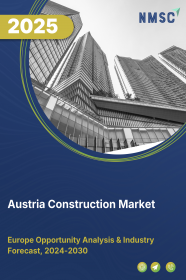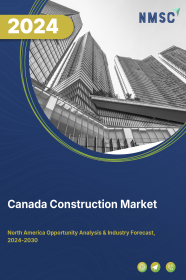
Asia-Pacific Construction Market by Type (Renovation, and New Construction), by Construction Method (Traditional, Prefabricated/Modular, 3D-Printed, and Green/Sustainable), by Contractor Type (Large Contractor, Medium Contractor, and Small Contractor), and Sector (Real Estate, Commercial, Infrastructure, Industrial) – Industry Trends and Forecast, 2025–2030
Industry: Construction & Manufacturing | Publish Date: 05-Jun-2025 | No of Pages: 145 | No. of Tables: 158 | No. of Figures: 103 | Format: PDF | Report Code : CM2228
US Tariff Impact on Asia-Pacific Construction Market
Trump Tariffs Are Reshaping Global Business
Asia-Pacific Construction Industry Overview
The Asia-Pacific Construction Market size was valued at USD 5.69 trillion in 2024, and is predicted to reach USD 6.21 trillion by the end of 2025. The industry is predicted to reach USD 8.64 trillion by the end of 2030, at a CAGR of 6.8% from 2025 to 2030.
The market is experiencing dynamic growth, driven by strong government funding, sustainability goals, regulatory developments, and digital innovation. In the Asia-Pacific region, countries like China and India are making substantial investments in transportation, renewable energy, and urban development, with a focus on green building and energy efficiency.
South Korea is reinforcing its carbon neutrality goals by implementing stricter green construction standards, advancing sustainable development. However, regulatory complexities, continue to pose challenges, as infrastructure projects require extensive approvals and adherence to evolving environmental standards.
At the same time, the integration of digital technologies, specially Building Information Modeling (BIM), is transforming infrastructure planning and execution by enhancing collaboration, efficiency, and lifecycle management, offering significant opportunities for market expansion.
As these trends continue, the global market is poised for continued innovation and growth, with digital transformation and sustainable development at its core.
Government Funding Drives Growth in the Asia-Pacific Infrastructure Sector
The Asia-Pacific construction market is thriving due to significant government investments in infrastructure projects. Key focus areas include transportation, energy, water systems, and urban development.
In 2024 International Trade Administration report highlights China's commitment to infrastructure, with substantial funding for transportation, renewable energy, water systems, and smart urbanization, while prioritizing green building and energy efficiency.
Similarly, India's National Infrastructure Pipeline has boosted funding in 2024, allocating 25% to renewable energy, 19% to roads and highways, 16% to urban infrastructure, and 13% to railways, emphasizing sustainable development. These investments are driving regional growth and modernization throughout the region.
Emphasis on Environmental Sustainability Driving Growth in the Asia-Pacific Construction Market Demand
There is a strong emphasis on environmentally friendly building practices and energy efficiency, which continues to drive growth in the construction market across the region. Recently, Seoul City in South Korea reinforced its green building regulations, introducing updated standards that require new constructions and major renovations to adopt energy-saving technologies and sustainable materials.
These measures support Seoul’s broader strategy to achieve carbon neutrality by 2050. The city also launched incentives for developers incorporating renewable energy systems and smart building technologies, further accelerating the transition to eco-friendly urban development.
Navigating Regulatory Complexities Impedes Asia-Pacific Construction Market Expansion
The infrastructure sector continues to encounter major challenges due to complex and evolving regulatory frameworks. Projects require multiple permits and approvals across local, regional, and national levels, including compliance with zoning laws, environmental assessments, building codes, and safety standards. These processes lead to significant delays and increased costs due to bureaucratic inefficiencies and inconsistent regulations between jurisdictions.
The Integration of Digitalization and Building Information Modeling (BIM) Creates New Growth Opportunities
The ongoing digital transformation in the construction industry, coupled with the growing adoption of Building Information Modeling (BIM), is creating a substantial market opportunity that is fueling sector growth.
BIM enables stakeholders to digitally design, manage, and simulate building infrastructure, improving accuracy, reducing errors, and enhancing coordination among teams. This technology has become crucial for increasing productivity, minimizing delays, and optimizing resource allocation in construction projects.
A prime example of this shift is the April 2024 launch of Allplan 2024 by ALLPLAN, which bolsters BIM capabilities and cloud-based workflows, underscoring the industry's movement towards digital project execution.
Moreover, the integration of BIM with emerging technologies like artificial intelligence (AI), the Internet of Things (IoT), and cloud computing facilitates real-time data sharing, predictive maintenance, and more efficient facility management.
China Dominates the Asia-Pacific Construction Market Share
China’s construction market is experiencing strong growth, driven by extensive government-led infrastructure initiatives aimed at expanding transportation networks, enhancing sustainability, and strengthening disaster resilience. In 2024, the Ministry of Transport allocated USD 173 billion to transport infrastructure, covering 2,500 km of high-speed rail and 461,000 km of highways.
Notable developments include the USD 7.8 billion Shenzhen-Zhongshan Link, a 24-km bridge-tunnel that opened in 2024, and the USD 4.2 billion Chongqing-Kunming High-Speed Rail, advancing in 2025.
Efforts to promote sustainability include a 47.6% rise in EV charging infrastructure by March 2025, reaching 3.43 million charging piles, and the replacement of 20,000 diesel locomotives with electric models in 2024, supported by the National Energy Administration. These advancements are financed through USD 208 billion in special-purpose bonds issued in 2024, underscoring China’s commitment to modernizing infrastructure and advancing carbon neutrality.
Additionally, the China construction industry continues to benefit from surging investments, with substantial government funding targeting transportation, energy, and digital infrastructure.
In 2024, USD 92.4 billion was invested in Belt and Road Initiative projects across 149 countries, including USD 11.8 billion in green energy ventures such as solar and wind farms in Saudi Arabia and Uzbekistan, as per the Green Finance & Development Center.
Domestically, USD 144 billion in ultra-long special treasury bonds funded 182 major projects, each exceeding USD 138 million in value, according to Global Times.
The energy sector saw an infusion of USD 15 billion in renewable initiatives, including the addition of 12 GW of offshore wind capacity, while digital infrastructure expanded with 54.81 million km of fiber-optic cables by 2023. Supported by a steady 0.97% inflation rate in 2024, these developments reinforce the country’s infrastructure modernization efforts and bolster long-term economic resilience.
India to Witness Substantial Growth in the Asia-Pacific Infrastructure Market
India’s construction market is undergoing significant growth, primarily driven by comprehensive government-backed programs focused on infrastructure expansion and urban transformation. The extended National Investment Pipeline (NIP), now projected through 2030, has prioritized funding across critical sectors including renewable energy, roadways, urban infrastructure, and railways.
Key projects advancing under this framework include the Mumbai–Ahmedabad High-Speed Rail, supported by Japan and set for completion by 2028, and the Chennai–Bengaluru Expressway, expected to be finalized by 2025.
The momentum is further sustained by the 2024 Union Budget, which has allocated substantial resources toward infrastructure, reflecting the government’s intent to meet rising urbanization and population-driven demand.
Additionally, the India construction market market is gaining additional traction through the growing emphasis on sustainable and smart infrastructure. The updated NIP outlines investments of USD 471 million for 50 GW of solar and wind energy capacity and USD 200 million for smart city initiatives leveraging IoT and AI-based systems during 2024–2025.
Major developments include the USD 12 billion expansion of 15 metro rail systems across cities like Delhi, Bengaluru, and Hyderabad, featuring energy-efficient designs, and the USD 5 billion PM Awas Yojana Urban 2.0, launched in 2024 to construct 10 million affordable, eco-friendly homes by 2027. Together, these initiatives reflect India’s strategic alignment with climate objectives and digital modernization goals, positioning the construction sector as a key pillar of national development.
Competitive Landscape
The key players operating in the Asia-Pacific construction industry include China State Construction Engineering Corp. Ltd. (CSCEC), China Railway Group Ltd. (CREC), China Communications Construction Group Ltd. (CCCC), Power Construction Corp. of China, China Energy Engineering Corporation (CEEC), Shanghai Construction Group (SCG), Sichuan Road and Bridge (Group) Co. Ltd., Kajima Corporation, Shimizu Corporation, Taisei Corporation, Larsen & Toubro (L&T), DLF Limited, GMR Group, Samsung C&T Corporation, Hyundai Engineering & Construction Co., Ltd.
Asia-Pacific Construction Market Key Segments
By Type
-
Renovation
-
New Construction
By Construction Method
-
Traditional Construction
-
Prefabricated/Modular Construction
-
3D-Printed Construction
-
Green/Sustainable Construction
By Type of Contractor
-
Large Contractor
-
Medium Contractor
-
Small Contractor
By Sector
-
Real Estate
-
Residential
-
Affordable
-
Luxury
-
-
Commercial
-
Retail Buildings
-
Office Buildings
-
Hospitality
-
Healthcare Facilities
-
Educational Institutes
-
Entertainment Ventures
-
-
-
Infrastructure
-
Transportation
-
Airport
-
Port
-
Rail
-
Road
-
-
Water and Wastewater
-
Energy
-
Telecommunication
-
-
Industrial
-
Manufacturing Plant
-
Warehouses
-
Power Plants
-
Oil Refineries
-
Chemical Plants
-
By Country
-
China
-
Japan
-
India
-
South Korea
-
Australia
-
Indonesia
-
Singapore
-
Taiwan
-
Thailand
-
Rest of Asia-Pacific
Key Players
-
China State Construction Engineering Corp. Ltd. (CSCEC)
-
China Railway Group Ltd. (CREC)
-
China Communications Construction Group Ltd. (CCCC)
-
Power Construction Corp. of China
-
China Energy Engineering Corporation (CEEC)
-
Shanghai Construction Group (SCG)
-
Sichuan Road and Bridge (Group) Co. Ltd.
-
Kajima Corporation
-
Shimizu Corporation
-
Taisei Corporation
-
Larsen & Toubro (L&T)
-
DLF Limited
-
GMR Group
-
Samsung C&T Corporation
-
Hyundai Engineering & Construction Co., Ltd.
REPORT SCOPE AND SEGMENTATION:
|
Parameters |
Details |
|
Market Size in 2024 |
USD 5.69 Trillion |
|
Revenue Forecast in 2030 |
USD 8.64 Trillion |
|
Growth Rate |
CAGR of 6.8% from 2025 to 2030 |
|
Analysis Period |
2024–2030 |
|
Base Year Considered |
2024 |
|
Forecast Period |
2025–2030 |
|
Market Size Estimation |
Trillion (USD) |
|
Growth Factors |
|
|
Countries Covered |
10 |
|
Companies Profiled |
15 |
|
Market Share |
Available for 15 companies |
|
Customization Scope |
Free customization (equivalent up to 80 working hours of analysts) after purchase. Addition or alteration to country, regional, and segment scope. |
|
Pricing and Purchase Options |
Avail customized purchase options to meet your exact research needs. |

















 Speak to Our Analyst
Speak to Our Analyst

















